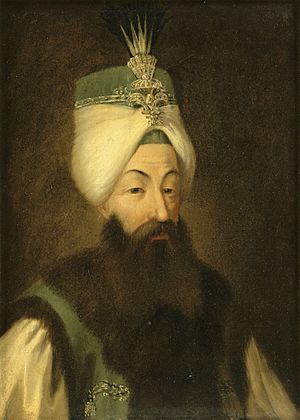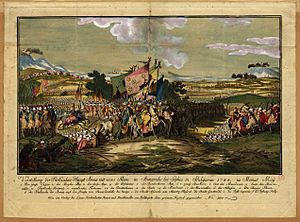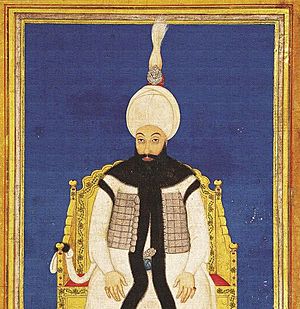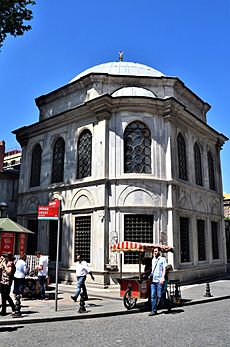Abdul Hamid I facts for kids
Quick facts for kids Abdul Hamid I |
|||||
|---|---|---|---|---|---|
| Ottoman Caliph Amir al-Mu'minin Custodian of the Two Holy Mosques Khan |
|||||
 |
|||||
| Sultan of the Ottoman Empire (Padishah) | |||||
| Reign | 21 January 1774 – 7 April 1789 | ||||
| Predecessor | Mustafa III | ||||
| Successor | Selim III | ||||
| Born | 20 March 1725 Topkapi Palace, Constantinople, Ottoman Empire |
||||
| Died | 7 April 1789 (aged 64) Constantinople, Ottoman Empire |
||||
| Burial | Tomb of Abdul Hamid I, Fatih, Istanbul | ||||
| Consorts |
|
||||
| Issue Among others |
|
||||
|
|||||
| Dynasty | Ottoman | ||||
| Father | Ahmed III | ||||
| Mother | Şermi Kadın | ||||
| Religion | Sunni Islam | ||||
| Tughra |  |
||||
Abdul Hamid I (born March 20, 1725 – died April 7, 1789) was the 27th Sultan of the Ottoman Empire. He ruled the Ottoman Empire from 1774 to 1789.
Contents
Early Life of Abdul Hamid I
Abdul Hamid was born on March 20, 1725, in Constantinople (modern-day Istanbul). He was a younger son of Sultan Ahmed III, who ruled from 1703 to 1730. His mother was Şermi Kadın.
After his father, Ahmed III, stepped down, his nephew Mahmud I became sultan. Then, Mahmud I was followed by his brother Osman III, and Osman III by Ahmed's older son Mustafa III.
As a possible future ruler, Abdul Hamid was kept in a special part of the palace called the "Kafes" (cage). This was a common practice to keep potential heirs safe but also away from politics. He stayed there until 1767. During this time, his mother, Rabia Şermi, taught him history and beautiful writing (calligraphy).
Abdul Hamid I's Reign
Becoming Sultan
When Sultan Mustafa III passed away on January 21, 1774, Abdul Hamid became the new sultan. A special ceremony was held in the palace. The very next day, Mustafa III's funeral took place.
The new sultan quickly sent a message to his top advisor, the Grand Vizier, telling him to continue the war against Russia. On January 27, 1774, Abdul Hamid went to the Eyüp Sultan Mosque. There, he received the Sword of Osman, a very important symbol for Ottoman sultans.
How He Ruled
Abdul Hamid's long time in the palace had made him less experienced in state matters. This meant his advisors had a lot of influence over him. However, he was also a very religious and peaceful person.
When he first became sultan, the government's money was very low. Because of this, he couldn't give the usual bonus to the Janissary soldiers. He told them, "There are no longer gratuities in our treasury, as all of our soldier sons should learn."

Abdul Hamid wanted to make the Ottoman Empire's military stronger. He worked to improve the Janissary army and the navy. He also created a new artillery (cannon) group and helped start the Imperial Naval Engineering School. This school taught people how to build and design ships.
He tried to strengthen Ottoman control over areas like Syria, Egypt, and Iraq. While there were some small wins against rebellions, these couldn't make up for losing the Crimean Peninsula. Crimea had become somewhat independent in 1774, but Russia actually controlled it.
Russia often used its role as a protector of Eastern Christians to get involved in the Ottoman Empire's business. Eventually, the Ottomans declared war against Russia in 1787. Soon after, Austria joined Russia.
At first, Turkey held its own in the fighting. But on December 6, 1788, the city of Ochakov fell to Russia. All the people living there were tragically killed. When Abdul Hamid I heard this terrible news, he had a stroke, which led to his death.
Despite these challenges, Abdul Hamid was seen as a very kind Ottoman Sultan. He even personally helped direct the fire brigade during a big fire in Constantinople in 1782. People admired him for his strong religious beliefs, and he was even called a Veli (meaning "saint"). He also started new reform plans, watched the government closely, and worked with important leaders.
After the war with Russia ended, Abdul Hamid I focused on problems inside the empire. He tried to stop internal rebellions with the help of Gazi Hasan Pasha from Algeria. He also worked on reforms with his advisors.
In Syria, a rebellion led by Zahir al-Umar was put down. This leader had worked with the Russian navy in the Mediterranean. Rebellions in Egypt were also stopped in 1775. The problems in Peloponnese (a region in Greece) also ended, and peace returned. Gazi Hasan Pasha and Cezzâr Ahmed Pasha were very important in stopping these uprisings.
Treaty of Küçük Kaynarca
Even though Abdul Hamid I was a peaceful person, the Ottoman Empire had to continue the ongoing war with Russia almost immediately after he became sultan. This led to a big defeat for Turkey at Kozludzha.
This defeat resulted in the embarrassing Treaty of Küçük Kaynarca, signed on July 21, 1774. With this treaty, the Ottomans gave up land to Russia. They also gave Russia the right to get involved on behalf of Orthodox Christian people living in the Ottoman Empire.
The treaty also allowed Russia to have an ambassador in Istanbul. This ambassador could take part in state ceremonies. Russia also gained the right to pass through the important Straits (waterways) and had full trading rights, similar to England and France. The treaty also said that Russia could build a church in Galata, which would be open to everyone and protected by Russian ambassadors.
Relations with Tipu Sultan
In 1789, Tipu Sultan, who ruled the Sultanate of Mysore in India, sent a group of representatives to Abdul Hamid. Tipu Sultan urgently asked for help against the British East India Company. He suggested that they form an alliance to defend each other and attack their enemies together.
However, Abdul Hamid told the Mysore representatives that the Ottomans were still busy and tired from their ongoing war with Russia and Austria. Because of this, they could not offer military help.
Architecture and Buildings
Abdul Hamid I had many buildings constructed, mostly in Istanbul. One of the most important is a large inn built in Sirkeci in 1777. Next to this inn, he also built a fountain, an elementary school, a madrasah (a school for Islamic studies), and a library. The books from this library are now kept in the Süleymaniye Library. The madrasah building is now used as a stock exchange.
During the building of the inn, a fountain had to be moved. It was placed at the corner of Zeynep Sultan Mosque, across from Gülhane Park.
In 1778, he also built the Beylerbeyi Mosque, which he dedicated to his mother, Râbia Şermi Kadın. He also had fountains built in Çamlıca Kısıklı Square. In 1783, he built a mosque, a fountain, a bath, and shops in Emirgân. Another fountain was built for Hümâşah Sultan and his son Mehmed. There is also a fountain near Neslişah Mosque in Istinye, and another one on the road between Dolmabahçe and Kabataş.
His Character
Abdul Hamid I was known for being very humble and religious. He would write down his concerns to his top advisors or governors. He also accepted invitations from his Grand Vizier and visited their homes, where they would read from the Quran.
He was very loving towards his children and enjoyed family life. He often spent summer months in Karaağaç, Beşiktaş, with his wives, sons, and daughters. His daughter Esma Sultan was known for her fashionable clothes and love for entertainment. Her style and travels with her companions even influenced the ladies of Istanbul.
Family
Abdul Hamid I is known for having wives even while he was kept in the Kafes before becoming sultan. This was unusual for the rules of the palace. From these relationships, at least one daughter was born secretly outside the palace. When Abdul Hamid became sultan, he brought her back to court and accepted her as his "adopted daughter."
Consorts (Wives)
Abdul Hamid I had at least fourteen consorts:
- Ayşe Kadın: His first main wife until she passed away in 1775.
- Hace Hatice Ruhşah Kadın: Became his main wife after Ayşe. She was his most beloved wife and was with him even before he became sultan. Five love letters he wrote to her have been saved. She was the mother of at least one son.
- Binnaz Kadın: Born around 1743. She did not have children.
- Nevres Kadın: Before becoming a wife, she managed the money in the palace women's section (harem).
- Ayşe Sineperver Kadın: Mother of at least two sons, including Mustafa IV, and two daughters.
- Mehtabe Kadın: She was a servant in the harem before becoming a wife.
- Muteber Kadın: Also called Mutebere Kadın. Mother of at least one son.
- Fatma Şebsefa Kadın: Also called Şebisefa, Şebsafa, or Şebisafa Kadin. Mother of at least one son and three daughters.
- Nakşidil Kadın: She was originally from Georgia or Circassia. She was the mother of two sons and one daughter, including Mahmud II.
- Hümaşah Kadın: Mother of at least one son. She built a fountain near Dolmabahçe and another in Emirgân.
- Dilpezir Kadın: She passed away in 1809.
- Mislinayab Kadın:
- Mihriban Kadın: She passed away in 1812.
- Nükhetseza Hanım: She was the youngest consort. She passed away in 1851.
Sons
Abdul Hamid I had at least eleven sons:
- Şehzade Abdüllah (born and died on January 1, 1776).
- Şehzade Mehmed (August 22, 1776 - February 20, 1781) - with Hümaşah Kadın. He passed away from smallpox.
- Şehzade Ahmed (December 8, 1776 - November 18, 1778) - with Ayşe Sineperver Kadın.
- Şehzade Abdürrahman (born and died on September 8, 1777).
- Şehzade Süleyman (March 13, 1778 - January 19, 1786) - with Muteber Kadın. He passed away from smallpox.
- Şehzade Ahmed (1779 - 1780).
- Şehzade Abdülaziz (born and died on June 19, 1779) - with Ruhşah Kadin.
- Mustafa IV (September 8, 1779 - November 16, 1808) - with Ayşe Sineperver Kadın. He became the 29th Sultan but ruled for less than a year.
- Şehzade Mehmed Nustet (September 20, 1782 - October 23, 1785) - with Şebsefa Kadın. His mother had a mosque built in his memory.
- Şehzade Seyfullah Murad (October 22, 1783 - January 21, 1785) - with Nakşidil Kadin.
- Mahmud II (July 20, 1785 - July 1, 1839) - with Nakşidil Kadin. He became the 30th Sultan of the Ottoman Empire.
Daughters
Abdul Hamid I had at least sixteen daughters:
- Ayşe Athermelik Dürrüşehvar Hanım (around 1767 - May 11, 1826). She was born when her father was still a prince and confined. Her birth was kept secret. When her father became sultan, he brought her back to the palace as his "adopted daughter." She married once and had two daughters.
- Hatice Sultan (January 12, 1776 - November 8, 1776). Her birth was celebrated for ten days.
- Ayşe Sultan (July 30, 1777 - September 9, 1777).
- Esma Sultan (July 17, 1778 - June 4, 1848) - with Ayşe Sineperver Kadın. She was called "Little Esma" to tell her apart from her aunt. She was close to her brother Mustafa IV. Later, she became a favorite sister of her half-brother Mahmud II, which gave her more freedom than other princesses. She married once but had no children.
- Melekşah Sultan (February 19, 1779 - 1780).
- Rabia Sultan (March 20, 1780 - June 28, 1780).
- Aynışah Sultan (July 9, 1780 - July 28, 1780).
- Melekşah Sultan (January 28, 1781 - December 24, 1781).
- Rabia Sultan (August 10, 1781 - October 3, 1782).
- Fatma Sultan (December 12, 1782 - January 11, 1786) - with Ayşe Sineperver Kadın. She passed away from smallpox. A fountain was built in her memory.
- Hatice Sultan (October 6, 1784 - 1784).
- Alemşah Sultan (October 11, 1784 - March 10, 1786) - with Şebsefa Kadın. Her birth was celebrated for three days.
- Saliha Sultan (November 27, 1786 - April 10, 1788) - with Nakşidil Kadin.
- Emine Sultan (February 4, 1788 - March 9, 1791) - with Şebsefa Kadın. Her father hoped she would live and gave her many gifts. She passed away from smallpox.
- Zekiye Sultan (? - March 20, 1788). She passed away as a baby.
- Hibetullah Sultan (March 16, 1789 - September 19, 1841) - with Şebsefa Kadın. She married once but had no children. She was later kept under close watch by her half-brother Mahmud II.
Death
Abdul Hamid I passed away on April 7, 1789, in Istanbul, at the age of sixty-four. He was buried in Bahcekapi, in a tomb he had built for himself.
He was very passionate about breeding Arabian horses. One type of Arabian horse, called "Küheylan Abdülhamid," was named after him.
See also
 In Spanish: Abdul Hamid I para niños
In Spanish: Abdul Hamid I para niños



